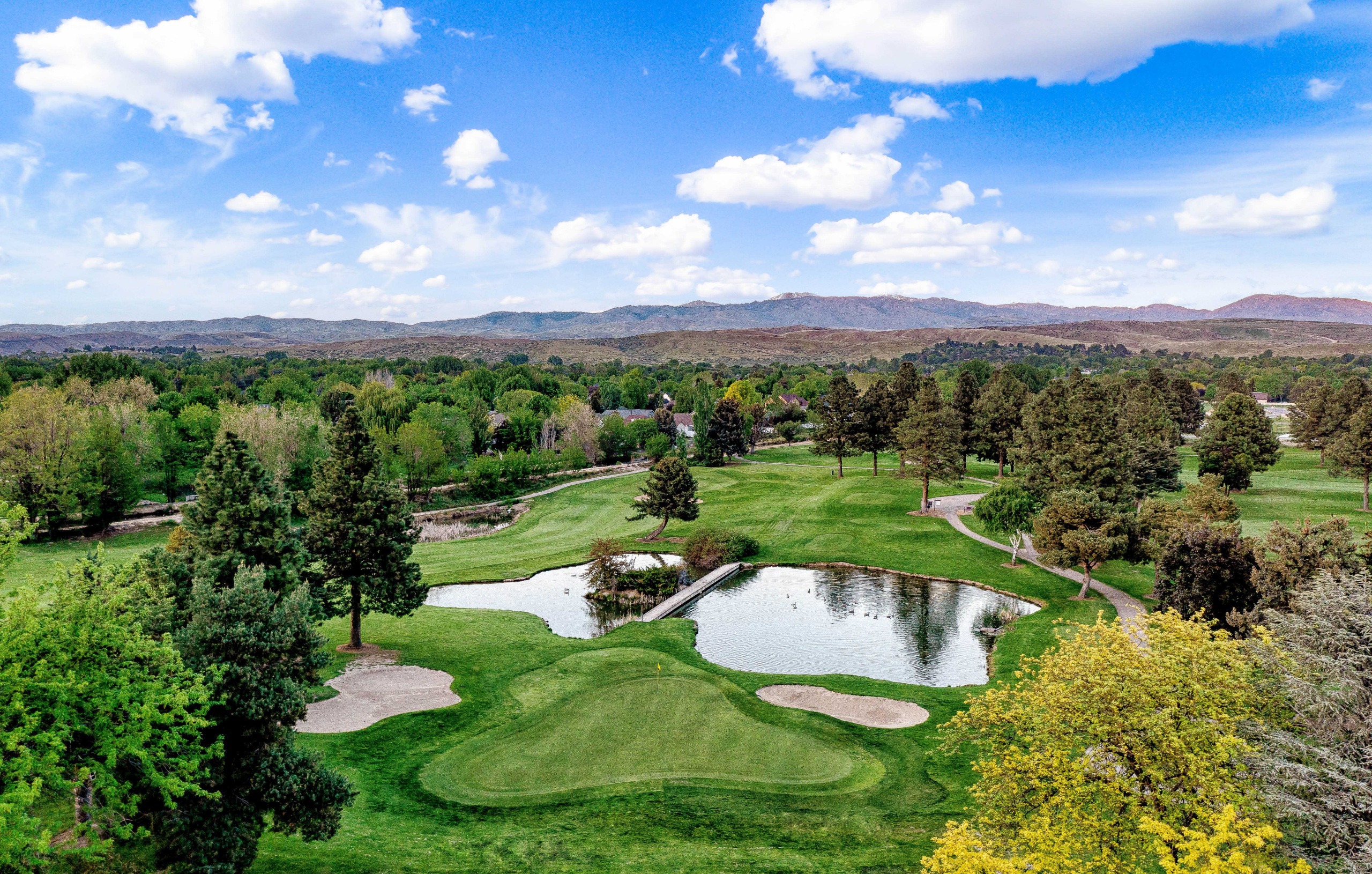Idaho's Golfing Seasons Overview
Spring kicks off the golfing year in Idaho with ideal conditions for both new and seasoned players. As temperatures range from 50°F to 70°F, golfers can relish in the refreshing air without feeling overwhelmed by heat. The serenity of the courses during this period means fewer crowds, allowing for a leisurely game. You might even spot local flora blooming beautifully along the fairways.

Picture a caddie skillfully navigating the course, offering not just support but also enhancing your game with strategic advice. Jane Doe, a devoted golfer, puts it simply: "Spring is my favorite season to golf because the fresh bloom around the courses adds to the scenic beauty." These pleasant conditions lay the groundwork for consistent play, enabling golfers to shake off any winter rust with ease, swinging drivers along the fairway with enthusiasm.
As spring transitions into summer, the golfing scene heats up—not only in temperature but also in sheer enthusiasm.

Summer: Peak Golfing Time
From June to August, Idaho experiences its warmest months, where temperatures typically soar between 70°F and 90°F. This makes summer a peak golfing season across picturesque courses like those in Boise, especially for those participating in local tournaments. However, while long days bathed in sunshine are ideal for golfers, sporadic heatwaves can pose challenges.
Preparation becomes essential—staying hydrated and applying sunscreen not only enhances enjoyment of the game but also safeguards against the sun's intensity. Players who adapt their schedules to early mornings or late afternoons often enjoy optimal playing conditions while keeping cool in the shade. For those with a higher handicap, summer offers a chance to practice and improve their game, perhaps even with the help of a pro to perfect their swing. An insider tip? Always check forecast updates on platforms like AccuWeather prior to your round for peace of mind, and consider using a golf cart for navigating those longer distances under the sun.
Just as you think summer couldn't get any better, fall arrives with its own charm that adds another layer of enjoyment for golfers.
Fall: Mild and Pleasant
With temperatures dipping between 50°F and 80°F, fall is equally captivating for golfers. The mild climate invites players back outdoors after the summer heat eases. Picture this: vibrant hues of red, orange, and gold light up the golf courses as autumn foliage creates an enchanting backdrop for every swing. Navigating each hole, golfers must contend with the occasional challenge of a strategically placed bunker, adding excitement to the otherwise serene environment. John Smith, a local enthusiast shares his own sunshine-filled moments: "The fall foliage creates a picturesque golfing environment. Plus, the weather is just perfect." For many golfers in Idaho, fall represents a second wind—a chance to enjoy their sport amid stunning nature's display before winter rolls in.
However, as we transition into winter, one must prepare for quite different conditions.
Winter: For the Brave Hearts
While winter may not be most people’s first choice for golfing, it does offer unique opportunities for those daring enough to embrace the chill. With temperatures generally hovering between 20°F to 40°F, enthusiastic golfers can still find joy if adequately prepared—think thermal layers and hand warmers! Courses like Warm Springs Golf Course in Boise manage to remain playable through much of winter due to careful maintenance despite potential frost on the greens. Sure, winter golf can be more challenging; however, it's an exhilarating experience surrounded by a serene landscape untouched by many, a journey where determination outweighs the elements.
Recognizing these seasonal patterns allows golf lovers to maximize their time on Idaho’s beautiful courses throughout the year while remaining adaptable to changing conditions.
Monthly Weather Predictions
When planning your golfing outings in Idaho, understanding the month-to-month weather patterns is vital. This enables you to pick optimal days for a round of golf while preparing for unexpected changes that can come with Idaho's dynamic climate.
Each month presents unique conditions that can significantly affect your golf experience. Among the picturesque locations, the renowned Lake Coeur d'Alene offers a resort like no other, with stunning views and amenities that guests are sure to appreciate. Every golfer should check their scorecard and details of membership options provided by clubs around this scenic lake to make the most of their stay.
January
In January, temperatures typically range from 20°F to 35°F. It's no surprise that this time of year is characterized by snow and ice, creating challenging conditions for outdoor play. Most golf courses remain closed during this season—so instead of letting your golf clubs gather dust, consider indoor practice facilities or virtual simulators. This way, you keep your swing sharp while waiting for the spring thaw.
As we transition to February, golfers begin to feel a sense of anticipation as the days slowly start to warm up. Even experienced players use this time to indulge in lessons that focus on improving technique and understanding the intricate nuances of golf.
February
February sees temperatures creeping up slightly, ranging from a brisk 25°F to about 40°F, still predominantly chilly for a round on the green. Most courses might still be closed or in limited play mode due to lingering snow. However, if you can find an accessible course, be prepared for wet or muddy grounds after any melting. Remember to grab your waterproof shoes!
March brings further warming and slightly more rain, making it an exciting month for enthusiastic golfers.
March
In March, temperatures generally sit between 30°F and 55°F. Although it's still cool, signs of spring begin to show as some courses may reopen. Rainfall increases slightly to about 1.7 inches; thus, it's essential to check course conditions before heading out. Expect muddy fairways but invigorating breezes—a breath of fresh air after winter! the resort at Lake Coeur d'Alene offers a spectacular view and a rough that challenges even the most seasoned golfers.
As we march into April, things really start to bloom—literally and figuratively.
April
April marks a noticeable temperature hike ranging from 40°F to 65°F. With two inches of expected rainfall, this month can be unpredictable—the sun may shine one moment while showers follow the next. Golfing in April can feel like walking through a vibrant flower garden with fresh blooms everywhere. Just be sure to bring layers and stay updated on weather forecasts! For golf enthusiasts, the par at some courses offers a rewarding challenge that enhances the joy of the game.
Come May, and you will see both temperatures and excitement increase as spring transitions into early summer.
May
May shines as one of the best months for golf in Idaho with temperatures climbing from 55°F to 75°F and about two inches of rain usually falling throughout the month. The fairways reach pristine conditions as water helps nourish them back after winter dormancy. This is when planning your tee times becomes critical—late mornings or afternoons are often ideal since warmer days mean comfortable evenings. With membership options, you can ensure regular access to these lush courses and enjoy continuous golfing adventures.
Jumping forward into June produces summer-like conditions perfect for long rounds on the course!
June
In June, typical highs reach around 85°F while lows remain at approximately 60°F. Rainfall diminishes significantly to just over an inch; therefore, sunny skies dominate and provide favorable playing conditions almost every day. With nature flourishing all around you—the lush greenery makes for beautiful scenery as you putt away amid brilliant blue skies. Guests at nearby resorts take full advantage of the delightful weather, enjoying magnificent sunsets post-golf.
Then we hit July—a peak summer month known for its warmth and dry conditions.
July
In July, average temperatures rise even higher, hitting around 65°F to sometimes reaching up to 90°F! It is important here to catch the optimal time for golfing—early mornings or late afternoons present temperatures that are comfortable enough while avoiding peak sun exposure. The best part? July is one of Idaho’s driest months with precipitation averaging less than half an inch—perfect conditions that reduce cancellations and provide uninterrupted playtime. A well-organized scorecard will help keep track of personal bests during this glorious month.
After enjoying July, August follows with similar weather—ideal if you capitalize on cooler hours!
August
August carries over warm summer vibes with highs around 88°F and lows flirting with mid-60s again, leading to pristine playing conditions throughout nearly every day. Wind speeds may gradually increase towards late afternoons at approximately 15 mph—keep this in mind during your drives and approach shots!
As we move into September, tranquility begins to settle back over autumn golf.
September
September is arguably one of the most delightful months for golfers in Idaho. With fewer crowds, serene landscapes, and ideal golfing conditions, it presents a unique opportunity to refine skills learned in previous months. Taking in the detailed beauty of courses near Lake Coeur d'Alene might even inspire new strategies and play styles.With daytime temps ranging from 60°F to 80°F and reduced rainfall (about one inch), you're set up for adrenaline-filled rounds on comfortably warm days—evenings call forth cooler breezes as summer heat wanes. Whether reflecting on these experiences in the peaceful environment of a lake or sharing moments on Instagram, the memories created are invaluable.
October signals a turning leaf—not just in colors but also in playability. It's a unique time of year when the world around you changes dramatically, and the natural beauty of Coeur d'Alene enchants every visitor. From there, a short drive to Spokane offers additional golfing opportunities as you compile your list of must-play courses.
October
October brings milder conditions where highs drop around 65°F while lows dip down to neutralize cooler night air at about 45°F. The flavor of fall comes alive; it’s essential now more than ever to check daily weather forecasts as unpredictable shifts lead up toward early snowfall later in the month. Remember, each round you play writes another chapter in your golfing diary, another story to share with friends and family.
Finally, November arrives—signaling preparations ahead of winter. Here, the golfers’ rights to a perfect round start to wane as chillier air sets in.
November
November tempts golfers with its cooling grip of autumn where high temps hover around 50°F against lows plummeting into chill near freezing at roughly 35°F. Approximately an average of over an inch and a half worth of precipitation again creates damp playing surfaces; therefore opt for short rounds before winter strikes fiercely.
Wrapping up the year's cycle—and just when you think you're safe—it’s December’s frosty embrace that takes hold, right after November leaves.
December
December typically ushers in cold weather where snow and ice become common across Idaho golf courses. Golfing opportunities dwindle significantly during this month yet numerous enthusiasts may seek indoor alternatives or at least dream of returning once spring reawakens the green expanses. It's the perfect moment to look back on your year's adventures and perhaps plan a return to a warmer world.
As we shift focus to the impact of weather and how it shapes the golfing season, it's clear that wind and rain can dramatically alter the playing conditions on any golf course. For golfers in Idaho, where the average precipitation is around 12 inches annually, May and June tend to be particularly wet months. During these times, understanding how rain affects the course is crucial. Wet greens behave differently; they become slower as water clogs the grass blades, reducing roll distance. Fairways soften as well, making hitting your target more challenging, as the ball may sink deeper into the turf upon landing.
